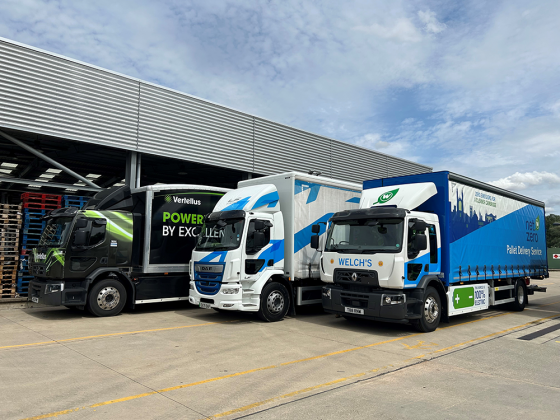What’s the alternative?
Gloria Esposito and Neil Wallis from the Low Carbon Vehicle Partnership (LowCVP) sum up some greener fuel options for fleet managers
 The historical domination of petrol and diesel in the transport fuels market is likely to continue for some time, but vehicle fleets powered by alternative fuels are becoming increasingly commonplace in the UK and elsewhere. A combination of European regulation, tax incentives (introduced at national level to support regulation), fuel price increases and the wider availability of alternative vehicle and refuelling technologies is driving this wider adoption.
The historical domination of petrol and diesel in the transport fuels market is likely to continue for some time, but vehicle fleets powered by alternative fuels are becoming increasingly commonplace in the UK and elsewhere. A combination of European regulation, tax incentives (introduced at national level to support regulation), fuel price increases and the wider availability of alternative vehicle and refuelling technologies is driving this wider adoption.
Sifting through the options
There are a number of different options to look at when investigating greener fuels, dependent on fleet type and usage. But the most prominent – and likely to be most practical for many – is electricity.
For specific situations, natural gas – or biomethane – may also be an option, especially for depot-based fleets. Biofuels (biodiesel and bioethanol) derived from crops and waste products are already present – at up to five per cent volume – in diesel and petrol and the proportion may increase in future, depending on the course of European legislation.
For the enthusiastic early adopter, hydrogen and fuel cell vehicles have long-term potential. There have been limited fleet trials to date but logistics are relatively complex and costs high, though these can be borne by other stakeholders. Commercial Group has the only commercial fleet in the UK to have adopted hydrogen as an alternative fuel. The company operates one hydrogen van and an innovative electrolyser-based hydrogen refuelling system powered by solar panels.
Electric Power
Electricity used to power plug-in hybrid and pure battery electric vehicles can significantly cut tailpipe greenhouse gas emissions, as well as reducing – or eliminating – local pollution and noise.
The carbon intensity of electricity generation, of course, influences the life‑cycle emissions of electric vehicles. A reduction in life-cycle carbon emissions of over 50 per cent is currently possible based on UK average grid factors.
Moreover, electricity is widely available across the UK and further decarbonisation of the grid is planned over the coming decades, driven by regulation and legislation to support carbon plan targets.
Incentives to plug-in
From the fleet operator’s viewpoint, the financial case for adoption plug-in hybrid or battery electric vehicles is becoming increasingly attractive. The government’s Plug-in Car Grant offers 25 per cent, or up to £5,000, as a subsidy on the purchase of new electric cars, and the number of vehicle choices are growing. Unsubsidised vehicle costs are also falling. Nissan, which has just begun producing the electric Leaf in Sunderland, recently announced a price reduction for its market-leading battery electric model.
For van operators, the more recently introduced Plug-in Van Grant offers a 20 per cent – up to £8,000 – subsidy towards the purchase of a growing range of van models.
While plug-in vehicles are invariably more expensive than their petrol/diesel counterparts at purchase, viewed on a Total Cost of Ownership (TCO) basis the figures look much more attractive and can, in certain circumstances, lead to significant cost savings.
Annual electricity costs are up to 75 per cent cheaper than diesel fuel, with further savings accessible from company car tax, excise duties and parking as well as potentially lower maintenance and servicing costs.
Current research and development is exploring advanced battery chemistry to improve battery energy density (and therefore range) and recharging facilities are now much more widely available. The government recently announced a further phase of its ‘Plugged-in Place’ programme which will see recharging points installed by local authorities, at modal interchanges, fleet depots, car parks and on major routes.
Though current technology for charging batteries is considerably slower than equivalent hydrocarbon refuelling, fast chargers – though more expensive to install – can reduce charging times by around 80 per cent and make longer journeys viable. For the time being though, plug-in vehicles continue to be most suited to routine – and mainly limited range uses – in urban areas.
The Energy Saving Trust (a LowCVP member) is currently offering free advice to 100 organisations considering the introduction of electric vehicles to their fleets. The Plugged-in Fleets Initiative provides free analysis and a tailored review including a whole-life cost analysis. (For more information see www.energysavingtrust.org.uk).
Natural Gas
Natural gas has a long track record as an alternative fuel but adoption has been more widespread in Europe and elsewhere than in the UK. Like natural gas, biomethane – which is chemically identical to natural gas, produced by the anaerobic digestion of organic matter – can also be used in spark ignition or dual‑fuel vehicles. The use of biomethane as a road fuel is presently a niche market but is likely to grow with further government support. Private and public sector fleets adopting biomethane include Howard Tenens, Coca Cola Enterprise, Waitrose, Sainsburys, Eddie Stobart and the London Borough of Camden.
One of the challenges of adopting natural gas or biomethane is the limited availability of publicly accessible compressed natural gas (CNG) refuelling infrastructure, though some fleet operators offer third-party access to their refuelling stations. The London Borough of Camden and Howard Tenens, for example, offer access to supplies of biomethane.
The government’s Low Carbon Truck Demonstration trial has provided grant funding to a number of logistics fleet operators to install gas refuelling infrastructure. Natural gas and biomethane benefit from lower fuel duty than petrol, currently 28p/l which can help reducing fuel cost for high mileage fleets. (For interested operators, LowCVP members Cenex has published a ‘Biomethane Toolkit’ – see: www.cenex.co.uk)
Further information
www.lowcvp.org.uk






